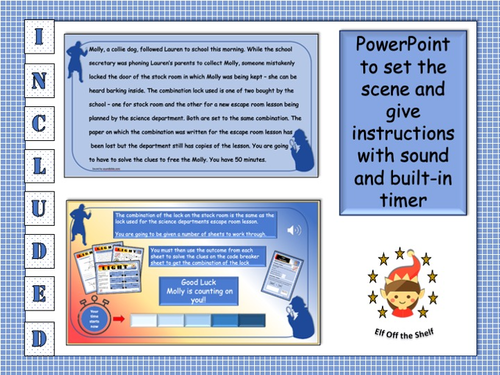






Finish and reinforce a middle school module on reflection, refraction and lenses or revisit it prior to exams with this innovative, enjoyable and challenging escape room lesson.
Students must work their way through the clues to find the code to a combination lock on the school storeroom where Molly, a pupil’s dog, has been accidentally locked after following the child to school and while the school secretary phones home.
Prior Knowledge Required
- Transparent, translucent and opaque materials
- Luminous and non-luminous objects
- Labelling the incident and reflected rays, the angles of incidence and reflection, the normal and the point of incidence
- Ray diagram showing how the eye sees an image in a plane mirror and in a periscope.
- The image formed in a plane mirror is upright, virtual (appears to be formed behind the mirror) laterally inverted, the same size as the object and as far behind the mirror as the object is in front.
- Specular and diffuse images
- The more dense the medium the slower the speed of light.
- When light travels from a less dense medium to a more dense medium it is bent towards the normal.
- Light hitting a boundary at ninety degrees is not refracted nor at a curved boundary.
- Why lightning is seen before thunder is heard when a cloud discharges.
- Real and apparent depth
- Ray diagrams showing refraction in a concave and convex lens.
- Convex lenses are used in magnifying glasses, telescopes and spectacles to correct long sight.
- Concave lenses are used in lasers, flashlights, peepholes and spectacles to correct short sight.
- Label the following structures on a diagram of the eye; retina; ciliary muscle; iris; pupil; lens; suspensory ligament; optic nerve.
- Ray diagrams to show how the eye sees distant and close objects.
- Ray diagrams to show how lenses are used to correct long and short sight.
- How the iris controls the size of the pupil and therefore the amount of light which enters the eye.
- The pinhole camera and the camera and compare with the eye.
The pack contains:
- PowerPoint – scene setting and instructions (sound effects and built-in timer);
- crossword;
- word search;
- dominoes activity;
- worksheet;
- code breaker sheet;
- answers;
- lesson plan.
If time is limited just the crossword, word search and domino can be used. The worksheet is the most challenging clue to solve and this can be omitted completely for less able classes.
Both 3 and 4 number combination locks can be purchased very cheaply online or the teacher can pretend to phone the school office for the staff to attempt to release the teacher.
More high quality resources available here.
Elf Off the Shelf Resources
Something went wrong, please try again later.
This resource hasn't been reviewed yet
To ensure quality for our reviews, only customers who have purchased this resource can review it
Report this resourceto let us know if it violates our terms and conditions.
Our customer service team will review your report and will be in touch.